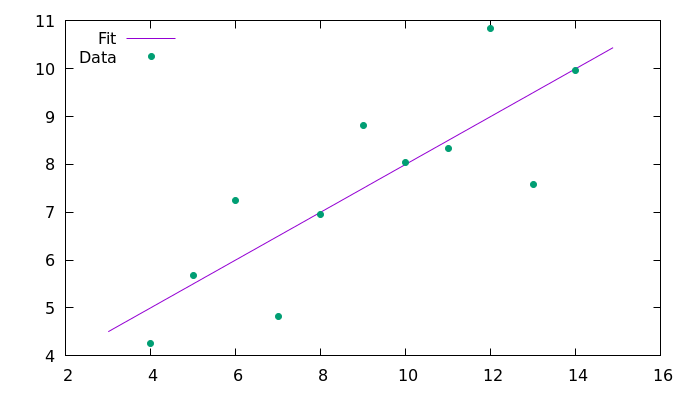c# 绘图 数据科学
尽管Python和R之类的语言在数据科学中越来越受欢迎,但是C和C ++对于高效的数据科学而言是一个不错的选择。 在本文中,我们将使用C99和C ++ 11编写一个使用Anscombe的四重奏数据集的程序,接下来我将对其进行解释。
我在一篇涉及Python和GNU Octave的文章中写了我不断学习语言的动机,值得回顾。 所有程序都应在命令行上运行,而不是通过图形用户界面 (GUI)运行。 完整的示例可在polyglot_fit信息库中找到 。
编程任务
您将在本系列中编写的程序:
- 从CSV文件读取数据
- 用直线内插数据(即f(x)= m⋅x + q )
- 将结果绘制到图像文件
这是许多数据科学家遇到的普遍情况。 示例数据是Anscombe四重奏的第一组,如下表所示。 这是一组人工构造的数据,当拟合直线时可以提供相同的结果,但是它们的曲线非常不同。 数据文件是一个文本文件,其中的制表符用作列分隔符,几行作为标题。 该任务将仅使用第一组(即前两列)。
安斯科姆四重奏
| 一世 | II | 三级 | IV | ||||
|---|---|---|---|---|---|---|---|
| x | ÿ | X | ÿ | X | ÿ | X | ÿ |
| 10.0 | 8.04 | 10.0 | 9.14 | 10.0 | 7.46 | 8.0 | 6.58 |
| 8.0 | 6.95 | 8.0 | 8.14 | 8.0 | 6.77 | 8.0 | 5.76 |
| 13.0 | 7.58 | 13.0 | 8.74 | 13.0 | 12.74 | 8.0 | 7.71 |
| 9.0 | 8.81 | 9.0 | 8.77 | 9.0 | 7.11 | 8.0 | 8.84 |
| 11.0 | 8.33 | 11.0 | 9.26 | 11.0 | 7.81 | 8.0 | 8.47 |
| 14.0 | 9.96 | 14.0 | 8.10 | 14.0 | 8.84 | 8.0 | 7.04 |
| 6.0 | 7.24 | 6.0 | 6.13 | 6.0 | 6.08 | 8.0 | 5.25 |
| 4.0 | 4.26 | 4.0 | 3.10 | 4.0 | 5.39 | 19.0 | 12.50 |
| 12.0 | 10.84 | 12.0 | 9.13 | 12.0 | 8.15 | 8.0 | 5.56 |
| 7.0 | 4.82 | 7.0 | 7.26 | 7.0 | 6.42 | 8.0 | 7.91 |
| 5.0 | 5.68 | 5.0 | 4.74 | 5.0 | 5.73 | 8.0 | 6.89 |
C方式
C是一种通用编程语言,是当今使用最广泛的语言之一(根据TIOBE索引 , RedMonk编程语言排名 , 编程语言索引的流行度和GitHub的八度状态提供的数据 )。 它是一种非常古老的语言(大约在1973年),并且用它编写了许多成功的程序(例如,Linux内核和Git仅举两个例子)。 它也是最接近计算机内部运行的语言之一,因为它直接用于操作内存。 它是一种编译语言 ; 因此,源代码必须由编译器翻译为机器代码 。 它的标准库很小,功能很少,因此开发了其他库来提供缺少的功能。
我最常使用数字处理数字 ,主要是因为它的性能。 我觉得使用起来很麻烦,因为它需要很多样板代码 ,但是在各种环境中都得到了很好的支持。 C99标准是最新版本,增加了一些漂亮的功能,并且受到编译器的良好支持。
我将一路介绍C和C ++编程的必要背景,以便初学者和高级用户都可以继续学习。
安装
要使用C99进行开发,您需要一个编译器。 我通常使用Clang ,但是GCC是另一个有效的开源编译器。 对于线性拟合,我选择使用GNU科学库 。 对于绘图,我找不到任何明智的库,因此该程序依赖于外部程序: Gnuplot 。 该示例还使用动态数据结构来存储数据,该结构在Berkeley Software Distribution (BSD)中定义。
在Fedora中安装就像运行一样容易:
sudo dnf install clang gnuplot gsl gsl-devel
注释码
在C99中,通过将//放在行的开头来格式化注释 ,其余行将被解释器丢弃。 另外, / *和* /之间的任何内容也将被丢弃。
// This is a comment ignored by the interpreter.
/* Also this is ignored */
必要的图书馆
库由两部分组成:
- 头文件 ,其中包含功能说明
- 包含函数定义的源文件
头文件包含在源文件中,而库的源文件与可执行文件链接 。 因此,此示例所需的头文件是:
// Input/Output utilities
#include <stdio.h>
// The standard library
#include <stdlib.h>
// String manipulation utilities
#include <string.h>
// BSD queue
#include <sys/queue.h>
// GSL scientific utilities
#include <gsl/gsl_fit.h>
#include <gsl/gsl_statistics_double.h>
主功能
在C语言中,程序必须位于名为main()的特殊函数内:
int main ( void ) {
...
}
这与上一教程中介绍的Python不同,后者将运行在源文件中找到的任何代码。
定义变量
在C语言中,变量必须在使用前声明,并且必须与类型相关联。 每当您要使用变量时,都必须决定要在其中存储哪种数据。 您也可以指定是否打算将变量用作常量值,这不是必需的,但是编译器可以从此信息中受益。 从存储库中的fitting_C99.c程序 :
const char * input_file_name = "anscombe.csv" ;
const char * delimiter = " \t " ;
const unsigned int skip_header = 3 ;
const unsigned int column_x = 0 ;
const unsigned int column_y = 1 ;
const char * output_file_name = "fit_C99.csv" ;
const unsigned int N = 100 ;
C中的数组不是动态的,因为它们的长度必须预先确定(即,在编译之前):
int data_array [ 1024 ] ;
由于您通常不知道文件中有多少个数据点,因此请使用单链列表 。 这是一个动态数据结构,可以无限增长。 幸运的是,BSD 提供了链接列表 。 这是一个示例定义:
struct data_point {
double x ;
double y ;
SLIST_ENTRY ( data_point ) entries ;
} ;
SLIST_HEAD ( data_list , data_point ) head = SLIST_HEAD_INITIALIZER ( head ) ;
SLIST_INIT ( & head ) ;
本示例定义了一个data_point列表,该列表由同时包含x值和y值的结构化值组成。 语法相当复杂,但很直观,详细描述它可能太冗长。
打印输出
要在终端上打印,可以使用printf()函数,其功能类似于Octave的printf()函数(在第一篇文章中介绍):
printf ( "#### Anscombe's first set with C99 #### \n " ) ;
printf()函数不会在打印字符串的末尾自动添加换行符,因此您必须添加它。 第一个参数是一个字符串,可以包含其他可以传递给函数的参数的格式信息,例如:
printf ( "Slope: %f \n " , slope ) ;
读取数据
现在来了困难的部分……有一些C语言用于CSV文件解析的库,但是似乎没有一个稳定或流行的库足以存在于Fedora软件包存储库中。 我没有为本教程添加依赖项,而是决定自己编写此部分。 同样,进入细节太罗word了,所以我只解释总体思路。 为了简洁起见,将忽略源代码中的某些行,但是您可以在存储库中找到完整的示例。
首先,打开输入文件:
FILE * input_file = fopen ( input_file_name , "r" ) ;
然后逐行读取文件,直到出现错误或文件结束:
while ( ! ferror ( input_file ) && ! feof ( input_file ) ) {
size_t buffer_size = 0 ;
char * buffer = NULL ;
getline ( & buffer , & buffer_size , input_file ) ;
...
}
getline()函数是POSIX.1-2008标准的一个很好的新增功能。 它可以读取文件中的整行,并负责分配必要的内存。 然后使用strtok()函数将每一行拆分为令牌 。 遍历令牌,选择所需的列:
char * token = strtok ( buffer , delimiter ) ;
while ( token != NULL )
{
double value ;
sscanf ( token , "%lf" , & value ) ;
if ( column == column_x ) {
x = value ;
} else if ( column == column_y ) {
y = value ;
}
column += 1 ;
token = strtok ( NULL , delimiter ) ;
}
最后,当选择了x和y值时,将新数据点插入到链表中:
struct data_point * datum = malloc ( sizeof ( struct data_point ) ) ;
datum -> x = x ;
datum -> y = y ;
SLIST_INSERT_HEAD ( & head , datum , entries ) ;
malloc()函数为新数据点动态分配(保留)一些持久性内存。
拟合数据
GSL线性拟合函数gsl_fit_linear()需要简单的数组作为其输入。 因此,由于您将不知道创建的数组的大小,因此必须手动分配它们的内存:
const size_t entries_number = row - skip_header - 1 ;
double * x = malloc ( sizeof ( double ) * entries_number ) ;
double * y = malloc ( sizeof ( double ) * entries_number ) ;
然后,遍历链接列表以将相关数据保存到数组:
SLIST_FOREACH ( datum , & head , entries ) {
const double current_x = datum -> x ;
const double current_y = datum -> y ;
x [ i ] = current_x ;
y [ i ] = current_y ;
i += 1 ;
}
现在您已经完成了链接列表,请清理它。 始终释放已手动分配的内存,以防止内存泄漏 。 内存泄漏是坏的,坏的,坏的。 每次不释放内存时,花园侏儒都会迷失自己的头:
while ( ! SLIST_EMPTY ( & head ) ) {
struct data_point * datum = SLIST_FIRST ( & head ) ;
SLIST_REMOVE_HEAD ( & head , entries ) ;
free ( datum ) ;
}
最后,finally(!),您可以适合您的数据:
gsl_fit_linear ( x , 1 , y , 1 , entries_number ,
& intercept , & slope ,
& cov00 , & cov01 , & cov11 , & chi_squared ) ;
const double r_value = gsl_stats_correlation ( x , 1 , y , 1 , entries_number ) ;
printf ( "Slope: %f \n " , slope ) ;
printf ( "Intercept: %f \n " , intercept ) ;
printf ( "Correlation coefficient: %f \n " , r_value ) ;
绘图
您必须使用外部程序进行绘图。 因此,将拟合函数保存到外部文件:
const double step_x = ( ( max_x + 1 ) - ( min_x - 1 ) ) / N ;
for ( unsigned int i = 0 ; i < N ; i += 1 ) {
const double current_x = ( min_x - 1 ) + step_x * i ;
const double current_y = intercept + slope * current_x ;
fprintf ( output_file , "%f \t %f \n " , current_x , current_y ) ;
}
用于绘制两个文件的Gnuplot命令是:
plot 'fit_C99.csv' using 1 : 2 with lines title 'Fit' , 'anscombe.csv' using 1 : 2 with points pointtype 7 title 'Data'
结果
在运行程序之前,必须对其进行编译:
clang - std = c99 - I / usr / include / fitting_C99. c - L / usr / lib / - L / usr / lib64 / - lgsl - lgslcblas - o fitting_C99
该命令告诉编译器使用C99标准,读取fitting_C99.c文件,加载库gsl和gslcblas ,然后将结果保存到fit_C99 。 命令行上的结果输出为:
#### Anscombe's first set with C99 ####
Slope: 0.500091
Intercept: 3.000091
Correlation coefficient: 0.816421
这是用Gnuplot生成的结果图像。
C ++ 11方式
C ++是一种通用编程语言,也是当今使用的最受欢迎的语言之一。 它是C的继承人 (于1983年创建),重点是面向对象的编程 (OOP)。 C ++通常被视为C的超集,因此C程序应该能够使用C ++编译器进行编译。 这并非完全正确,因为在某些极端情况下它们的行为有所不同。 以我的经验,C ++比C需要更少的样板,但是如果要开发对象,语法会更困难。 C ++ 11标准是最新版本,增加了一些漂亮的功能,并且或多或少受编译器支持。
由于C ++在很大程度上与C兼容,因此我只强调两者之间的差异。 如果我在本部分中没有涵盖任何部分,则意味着它与C中的相同。
安装
C ++示例的依赖项与C示例相同。 在Fedora上,运行:
sudo dnf install clang gnuplot gsl gsl-devel
必要的图书馆
库的工作方式与C中的相同,但是include指令略有不同:
#include <cstdlib>
#include <cstring>
#include <iostream>
#include <fstream>
#include <string>
#include <vector>
#include <algorithm>
extern "C" {
#include <gsl/gsl_fit.h>
#include <gsl/gsl_statistics_double.h>
}
由于GSL库是用C编写的,因此您必须将这种特殊性告知编译器。
定义变量
C ++比C支持更多的数据类型(类),例如比C具有更多功能的字符串类型。 相应地更新变量的定义:
const std :: string input_file_name ( "anscombe.csv" ) ;
对于字符串之类的结构化对象,可以不使用=符号来定义变量。
打印输出
您可以使用printf()函数,但是cout对象更惯用了。 使用运算符<<表示要使用cout打印的字符串(或对象):
std :: cout << "#### Anscombe's first set with C++11 ####" << std :: endl ;
...
std :: cout << "Slope: " << slope << std :: endl ;
std :: cout << "Intercept: " << intercept << std :: endl ;
std :: cout << "Correlation coefficient: " << r_value << std :: endl ;
读取数据
该方案与以前相同。 将打开文件并逐行读取文件,但语法不同:
std :: ifstream input_file ( input_file_name ) ;
while ( input_file. good ( ) ) {
std :: string line ;
getline ( input_file, line ) ;
...
}
使用与C99示例相同的功能提取行令牌。 代替使用标准C数组,请使用两个向量 。 向量是C ++标准库中C数组的扩展,它允许动态管理内存而无需显式调用malloc() :
std :: vector < double > x ;
std :: vector < double > y ;
// Adding an element to x and y:
x. emplace_back ( value ) ;
y. emplace_back ( value ) ;
拟合数据
为了适合C ++,您不必遍历列表,因为可以保证向量具有连续的内存。 您可以将向量缓冲区的指针直接传递给拟合函数:
gsl_fit_linear ( x. data ( ) , 1 , y. data ( ) , 1 , entries_number,
& intercept, & slope,
& cov00, & cov01, & cov11, & chi_squared ) ;
const double r_value = gsl_stats_correlation ( x. data ( ) , 1 , y. data ( ) , 1 , entries_number ) ;
std :: cout << "Slope: " << slope << std :: endl ;
std :: cout << "Intercept: " << intercept << std :: endl ;
std :: cout << "Correlation coefficient: " << r_value << std :: endl ;
绘图
使用与以前相同的方法进行绘图。 写入文件:
const double step_x = ( ( max_x + 1 ) - ( min_x - 1 ) ) / N ;
for ( unsigned int i = 0 ; i < N ; i + = 1 ) {
const double current_x = ( min_x - 1 ) + step_x * i ;
const double current_y = intercept + slope * current_x ;
output_file << current_x << " \t " << current_y << std :: endl ;
}
output_file. close ( ) ;
然后使用Gnuplot进行绘图。
结果
在运行程序之前,必须使用类似的命令对其进行编译:
clang ++ - std = c ++ 11 - I / usr / include / fitting_Cpp11. cpp - L / usr / lib / - L / usr / lib64 / - lgsl - lgslcblas - o fitting_Cpp11
命令行上的结果输出为:
#### Anscombe's first set with C++11 ####
Slope: 0.500091
Intercept: 3.00009
Correlation coefficient: 0.816421
这就是用Gnuplot生成的结果图像。

结论
GObject和Jansson库。对于数字运算,我更喜欢在C99中工作,因为它的语法更简单并且得到了广泛的支持。 直到最近,C ++ 11还没有得到广泛的支持,我倾向于避免使用先前版本中的粗糙边缘。 对于更复杂的软件,C ++可能是一个不错的选择。
您是否还将C或C ++用于数据科学? 在评论中分享您的经验。
翻译自: https://opensource.com/article/20/2/c-data-science
c# 绘图 数据科学






